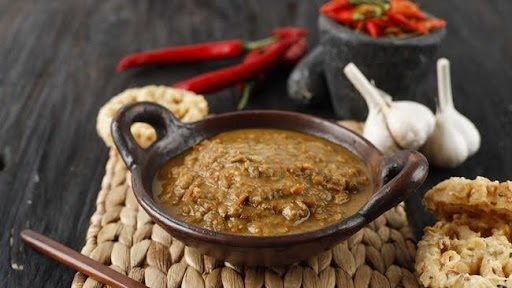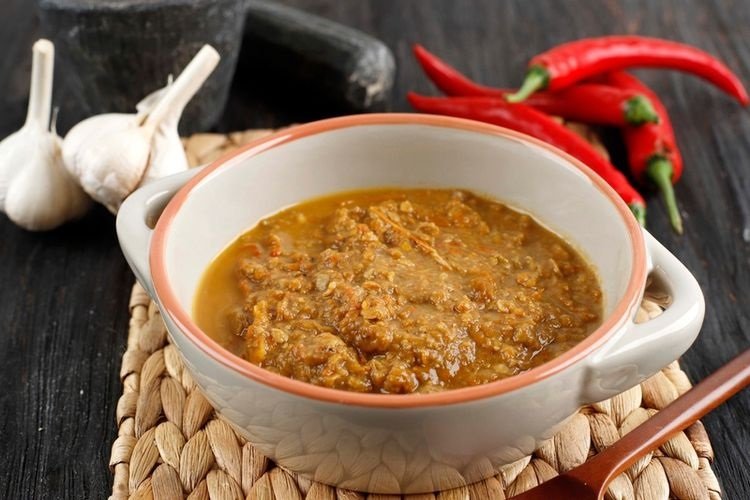Sambal Tumpang Tempe Semangit is precise because of the usage of tempe semangit, which is tempeh that has been fermented past its regular fermentation degree, resulting in a more potent taste and odor. This, together with an aggregate of aromatic spices and coconut, creates a sauce that is intensely flavorful and deeply pleasant.
The Historical Significance of Sambal Tumpang
Sambal Tumpang has a storied vicinity in Javanese delicacies. It originated from the kitchens of the Javanese royal courts, in which it was advanced to accompany quite a few meals. The addition of tempe semangit, which turned into historically seen as a way to apply over-fermented tempeh that might in any other case be discarded, reflects Javanese ingenuity in using available resources to beautify the taste in their dishes.
Recipe for Sambal Tumpang Tempe Semangit
Ingredients:
- two hundred grams of tempe semangit, kind of chopped
- a hundred grams of sparkling coconut, grated
- 2 tablespoons of coconut oil
- five shallots, peeled and finely chopped
- three cloves of garlic, peeled and finely chopped
- 2 large pink chilies, deseeded and finely chopped
- 1 teaspoon of galangal paste
- 1 teaspoon of tamarind paste
- 1 teaspoon of palm sugar
- Salt to flavor
Preparing the Base:
- Heat the Coconut Oil: Begin by heating coconut oil in a frying pan over medium warmth.
- Sauté Aromatics: Add the chopped shallots, garlic, and red chilies to the oil.
- Fry them until they’re golden and aromatic, which generally takes approximately 2-3 minutes.
- Mix in Galangal and Tamarind: Stir within the galangal and tamarind pastes, blending them very well with the sautéed aggregate.
Cooking the Tempe Semangit:
Add Tempe Semangit: Introduce the chopped tempe semangit to the pan. Fry it with the spice combination for about 5 minutes, or till it starts off evolved to brown barely.
Incorporate Coconut and Seasonings: Add the grated coconut, palm sugar, and a pinch of salt. Mix everything well.

Simmering the Sambal:
Add Water: Pour in just enough water to cowl the combination barely, so as to help in blending the substances smoothly.
Simmer the Mixture: Allow the sambal to simmer on low heat for about 10-15 mins, stirring every so often. The sambal should thicken and the oil will begin to bloom.
Final Adjustments:
Taste and Adjust: Taste the sambal and alter the seasoning as needed. The final product ought to be a harmonious stability of highly spiced, sweet, and bitter notes.
Cool Down: Remove the pan from warmness and permit the sambal calm down slightly earlier than serving.
Serving and Pairing Sambal Tumpang Tempe Semangit
Sambal Tumpang is traditionally served with steamed rice and numerous Javanese dishes such as fried fowl, grilled fish, or veggies. Its strong flavors make it a really perfect accompaniment that compliments the meal.
Preserving Sambal Tumpang Tempe Semangit
To shop Sambal Tumpang, maintain it in an hermetic box in the fridge. It usually stays suitable for as much as every week. As the flavors meld together over the years, you could locate that the sambal tastes even higher a day or after it’s made.
Making Sambal Tumpang Tempe Semangit is a journey into the coronary heart of Javanese culinary culture, imparting a flavor that is both complex and deeply fulfilling. This sauce no longer presents a glimpse into the resourcefulness of traditional Javanese cooking however , it also serves as a reminder of the way delicacies may be a shape of cultural expression. By attempting this recipe, you bring a chunk of Javanese background into your kitchen.
Nutritional Benefits of Tempe Semangit
Tempeh, together with its over-fermented shape, tempe semangit, is relatively appeared for its nutritional fee. Rich in protein, dietary fiber, and vitamins which includes B12, it is a staple in vegetarian and vegan diets. The fermentation technique additionally enhances the bioavailability of vitamins, making them less difficult for the frame to take in. Moreover, tempe semangit consists of probiotics, which might be beneficial for digestive fitness. By incorporating tempe semangit in sambal tumpang, you now not only enjoy a scrumptious sauce but additionally gain from a nutritionally rich food.
Cultural Significance and Modern Adaptations
Sambal Tumpang Tempe Semangit holds a special region in Javanese lifestyle, regularly featured at some stage in special events and ceremonies. It represents a culinary lifestyle that values sustainability and ingenuity, because it transforms over-fermented tempeh right into a connoisseur factor as opposed to discarding it. In cutting-edge instances, chefs and domestic chefs are exploring new methods to include this flavorful sambal into cutting-edge dishes, including fusion delicacies wherein it’s miles used as a base for revolutionary sauces or as a unique spread for gourmet sandwiches.

DIY Tips for Making Tempe Semangit at Home
While tempe semangit is traditionally acquired through extended fermentation, you can replicate a similar depth of taste at home through allowing tempeh to ferment for some greater days past its typical fermentation time. Ensure that it’s far saved in a heat, humid surroundings to promote the increase of the essential mould. This home made method permits you to modify the extent of fermentation to fit your flavor preferences.
Experimenting with Sambal Tumpang Variations
Sambal Tumpang is versatile and may be tailored to one-of-a-kind flavor alternatives. For folks that opt for a milder taste, reducing the quantity of chilies can help tame the warmth without compromising the overall taste profile. Additionally, experimenting with specific styles of coconut (consisting of desiccated coconut or coconut cream) can modify the texture and richness of the sambal. Some modern variations even contain seafood or bird to create a greater full-size dish, showcasing the adaptability of this conventional sauce.
Challenges and Considerations in Preparation
Preparing Sambal Tumpang Tempe Semangit calls for a cautious balance of flavors and an know-how of the fermentation technique of tempe semangit. One of the demanding situations is managing the pungency and the robust aroma of over-fermented tempeh, which might be overwhelming for some. Beginners must begin with small quantities and alter in line with their flavor tolerance. Additionally, ensuring the freshness and quality of all spices used is critical for accomplishing the first-class flavor.
Embracing Tradition and Innovation
Sambal Tumpang Tempe Semangit is greater than only a condiment; it’s a testament to the rich cultural tapestry of Java and its culinary traditions. By preparing this sambal, you not best preserve a bit of Javanese heritage alive however additionally interact with a sustainable, flavorful, and healthy meals exercise. Whether you’re a seasoned chef or a curious foodie, making Sambal Tumpang gives a possibility to discover conventional flavors at the same time as inviting innovation into your cooking. This sambal serves as a scrumptious reminder of how conventional dishes can be usually reinvented and loved across generations.
Engaging the Community with Sambal Tumpang Tempe Semangit
The education and leisure of Sambal Tumpang Tempe Semangit aren’t just culinary acts; they are social activities that deliver people collectively. In Javanese way of life, cooking is usually a communal attempt, particularly at some stage in celebrations and gatherings. Inviting buddies or own family to participate in the making of Sambal Tumpang may be a delightful manner to explore cultural traditions, share tales, and revel in the collective attempt of cooking. Additionally, network cooking workshops that specialize in conventional dishes like Sambal Tumpang can assist younger generations hook up with their background and examine precious cooking abilities.
Sustainability and Ecological Impact
In an age wherein meals sustainability is increasingly critical, Sambal Tumpang Tempe Semangit offers precious lessons on the usage of meals resources wisely. The use of over-fermented tempeh, which might otherwise be discarded, exemplifies an green method to cooking. By promoting dishes that make use of such elements, there’s an ability to influence current protogel culinary practices toward more sustainable conduct. This approach no longer handiest reduces waste however additionally encourages the culinary enterprise to reconsider how components are used and valued.
Marketing Sambal Tumpang to a Global Audience
While Sambal Tumpang is deeply rooted in Javanese lifestyle, it has the capacity to attract a worldwide palette, just like other Southeast Asian dishes that have found international repute. For marketers and culinary enthusiasts looking to introduce new flavors to foreign markets, Sambal Tumpang offers a unique combination of flavor and subculture. Marketing this dish globally may want to highlight its rich cultural heritage, its dietary blessings, and its versatility in diverse dishes. Moreover, by means of leveraging the developing interest in fermented meals inside the health and wellbeing sectors, Sambal Tumpang will be positioned as a gourmet and a health-conscious choice.
Educational Opportunities in Culinary Arts
Educational institutions that offer culinary arts programs may want to include traditional dishes like Sambal Tumpang Tempe Semangit into their curriculum. This would now not most effectively improve the students’ culinary capabilities but additionally increase their know-how of worldwide cuisines. By mastering about the historical contexts, ingredients, and strategies of traditional dishes, students can broaden an extra holistic view of what cooking entails and respect the variety of world meals cultures.
Celebrating and Preserving a Culinary Heritage
Sambal Tumpang Tempe Semangit is a testimony to the richness of Javanese cuisine, embodying flavors that are robust, complicated, and deeply tied to cultural traditions. As this dish continues to be made protogel in homes and restaurants throughout Java and beyond, it contains with it the stories and practices of past generations. For those out of doors of Java, experimenting with and adapting Sambal Tumpang can be an enlightening access into Javanese culture, imparting a taste that is both exceptional and homely. Ultimately, the continuing recognition and model of Sambal Tumpang highlight the dynamic, evolving nature of culinary traditions and their lasting impact on nearby and international scales.

